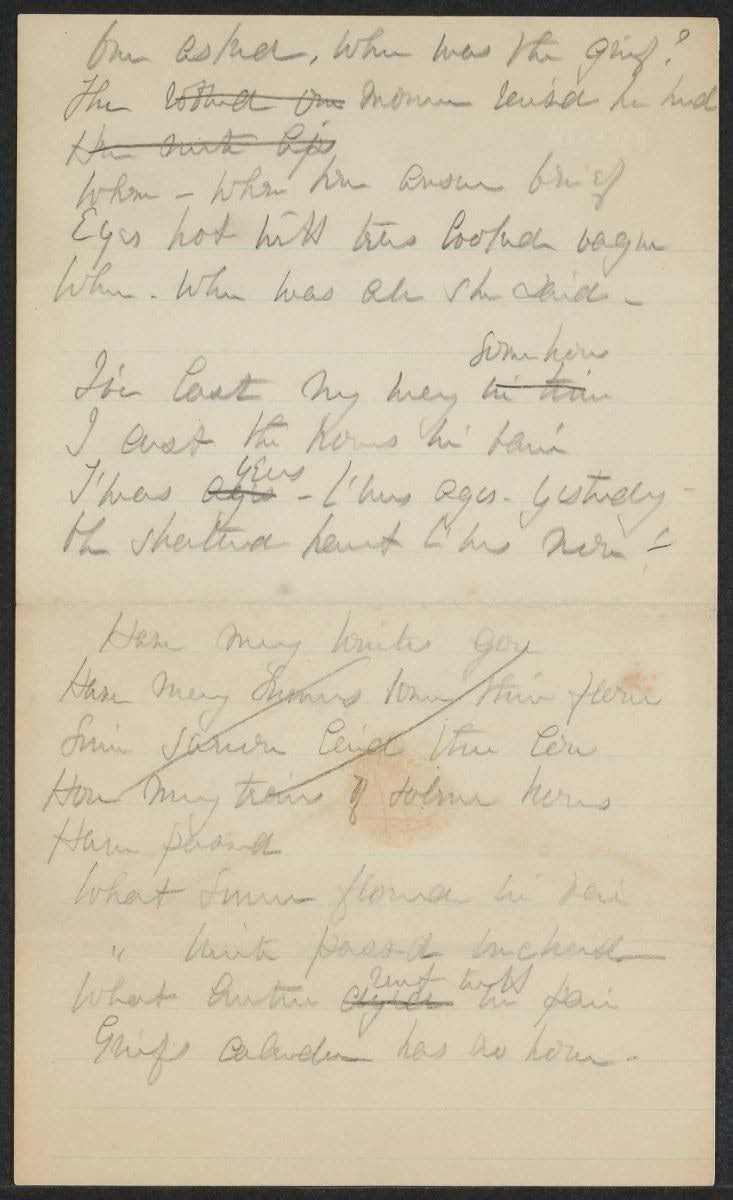Exhibition Location: "Poems" - "Pencil Drafts"
H bMS Am 1118.95, Box 9
C. 1889?. In handwriting similar to "Of June, and her belongings". Pencil. Blue-ruled stationery embossed "DOLPHIN" is similar to sheets used by ED. This is on the second leaf, fourth page of sheet folded to make two leaves that has "The robins choose to-day" on the first page.
Appears to be an early, working draft with formal goals. Consistent with her corpus, a lyric elegy in four stanzas (one of which she cancels). As the burial allusion "laid thee low" suggests, the poem was probably composed after her son Gib dies, a loss which triggers a year-long withdrawal from public duties. The biographical context of this tragedy and its painful aftermath may explain the resonance within a constellation of like poems and fragments, among them "Hyssop", "Irony", "Valentine's Day", "The robins choose to-day, "Fresher than dawn..." and possibly others.
In keeping with her formalizing practices, Susan works towards exact syllabics, (like "Hyssop," "Irony," "Valentine's Day"), in this case, timeter. A second draft would almost certainly adopt one consistent rhyme scheme, either alternating or even, as has been her practice in other similar poems.
Susan¹s drafts are consistently revealing of a certain tension in her poetics, as illustrated by the Emily-like slanted rhyme "head" / "vague" and the more orthodox variant she pens beneath it--the whole rhyme, "head"/ "said." Other revisions show a consistent poetic preference or practice, such as her cancellation of the third stanza, the most uneven of the four with its two-syllable internal rhymes, "showers"/ "flowers" and mixed metaphor. By contrast to the earlier "Did I but purpose..." (c.1861), this and its companion poems are less musically strained and demonstrate a more subtle use of assonance, and in this case, repetition.
The poem’s overall shape and sound point to mixed influences. Most obviously, Susan's "'T'was years -- 'twas ages -- yesterday" comes directly from Emily's unorthodoxy of economy. Like Emily's, Susan's punctual sectioning of the line is used in an effort to express the ineffable, the paradox of grief's time, that a day could be interchanged with a year; the formal mechanism mirrors that substitution where the dash replaces the understood syntactical part "'twas," effecting a side-by side juxtaposition of "ages" and "yesterday."
The poem also echoes the best of its printed contemporaries, in particular Tennyson's shorter dramatic-lyric pieces and Lydia Sigourney's famous "Death of an Infant" anthologized in the Evergreens' copy of Sacred Poets of England and America. (A comparison with Sigourney's demonstrates how, though common in theme, Susan's language and conceit are less generic and stylized, and her expression of grief more acute.)




